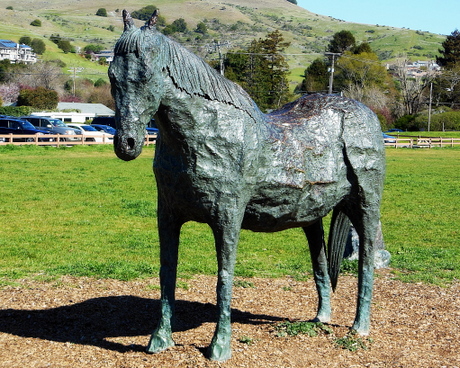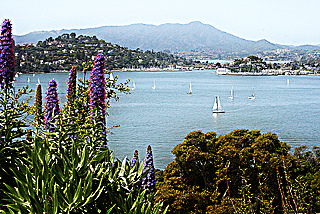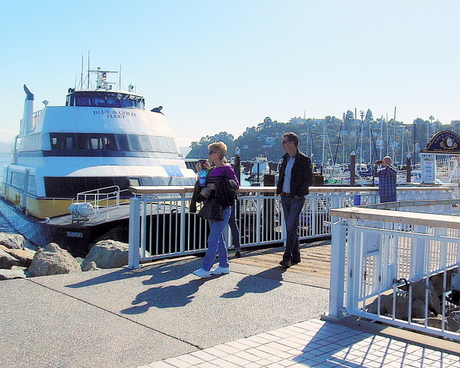Discovering the Adventure
Belvedere and Tiburon California
The Belvedere and Tiburon Peninsula was a mystery to me. Though I had visited Belvedere many years ago to dine with an aunt (she was house sitting for a friend), I didn't really have a personal feel for what the area was all about.
So one recent day Wolf and I decided to take a weekend to find out.
Almost entirely surrounded by San Francisco Bay, Belvedere/Tiburon Peninsula is nestled under the Golden Gate Bridge across the Bay from San Francisco.
These two communities were ranked by Forbes magazine as among the 20 most expensive real-estate markets in the U.S.
Thus the residents of the area are know for their affluence, their yacht clubs, their dedication to protecting the environment that they so enjoy, and their extraordinary views of San Francisco and the Bay.
Standing in one spot along the shore, you can see a goodly chunk of San Francisco Bay, Angel Island, Mount. Tamalpais, the city of San Francisco, the Golden Gate Bridge, and the Bay Bridge - all at the same time.
It's no wonder Belvedere Tiburon is a favorite Bay Area destination!
Background on Belvedere and Tiburon
Belvedere and Tiburon sprout from much more humble beginnings than their present-day personae would suggest.
Mario-Andretti-it
along the narrow switch-back roads that lead up into the hills to gawk
at the multimillion dollar estates perched on the hillsides - Sotheby's
is by far the most common listing agent - and the panoramic vistas
enjoyed everyday by those who reside there.
You would never
guess that Belvedere began as a humble commercial fishing community, or
that Tiburon was once a hustling industrial railroad town.
Belvedere is probably one of the smallest incorporated cities in the world at one square mile of property, a population of just over 2,000, and only three neighborhoods: Belvedere Island, Belvedere Lagoon, and Corinthian Island.
Don't go looking for Belvedere's downtown, though. There isn't any downtown - by design - and no restaurants or shops are allowed in the city. Belvedereans apparently eschew the idea of cultivating and attracting tourists, and are content to conduct most of their shopping and dining-out in nearby Tiburon or across the Bay.
So why go where you're not wanted, you may well ask. Trust us, gawking at the homes and the views is well worth an excursion.
Historic Belvedere
There are also a few historic buildings in Belvedere that students of history won't want to miss.
- China Cabin is the gilded and elegant social-saloon/Victorian drawing room from the side-wheel steamer, PMSS China - a first-class passenger ship that sailed from San Francisco to the Far East in the mid-1800s. While the ship is long gone, the saloon - in all its glory - is a fixture of the Belvedere waterfront.
- Belvedere City Hall - formerly the local Presbyterian Church - was moved from the original site to its current location in 1949. Many of its original features have been preserved and are on display.
- Drive along Beach Road and you'll discover many buildings that were designed by architect Albert Farr - the same man who designed Wolf House for Jack London in Glen Ellen. Unlike Wolf House, which was destroyed by fire, Mr. Farr's Belvedere buildings stand much now as they did then.
Taking the Ferry to Belvedere and Tiburon
Though still largely an insider secret, the picturesque and charming bay-side sailing village of Tiburon is known to many Bay Areans and a few tourists-in-the-know as a romantic day-trip travel destination or weekend getaway.
Originally, Tiburon was the last stop along the Northwestern Pacific Railroad before the lumber and supplies railed down from the north were transferred to barges for dispersal to various cities around the Bay Area.
But today you can take the ferry from Pier 41 at San Francisco's Fisherman's Wharf to find yourself in the heart of historic downtown Tiburon, a perfect jumping off place for all the things there are to scout out:
- Explore the downtown shops (Citrus, Paparazzi, Unique Boutique), galleries (Art Molinar, St. Germain), and restaurants (Ginza Sushi, Sam's, The Boathouse, Guaymas)
- Lunch on the outdoor patio at historic Sam's Anchor Cafe, a Tiburon fixture since 1920 and favorite Bay Area day-trip destination
- Stroll around the restaurants (Lily Kai) and shops (DeLeuse Jewelers, Ark Angels Flowers), and enjoy the lagoon and water features of Point Tiburon Plaza
- Board the Angel Island-Tiburon ferry to Angel Island for a day of hiking and exploring
- Capture the fantastic views photographically: Angel Island, San Francisco Bay, the Bay Bridge, San Francisco, Golden Gate Bridge, the hills of Belvedere and Tiburon, and Mt. Tamalpais
- Stroll Shoreline Park and visit the Tiburon Railroad and Ferry Depot Museum to learn about Tiburon's former incarnation as a rail town
- Discover historic Ark Row with its 1890s-era houseboats-turned-shops-and-restaurants - the houseboats formerly served as homes to railroad workers and Bohemian artists
- Motor up Paradise Drive into the hills for gorgeous homes and scenery, beautiful views, and ultimately, Paradise Beach County Park, situated along the east shore of the Tiburon Peninsula
- Walk, jog, or bike - bikes are allowed on the ferries, so you can bring your own - along the Tiburon Historical Trail from downtown to Blackie's Pasture and Richardson Bay (see more about THT below)
Discovering Historic Tiburon
 Sculpture of Tiburon's Beloved Black by Wolf Rosenberg
Sculpture of Tiburon's Beloved Black by Wolf RosenbergIf you really want to know Tiburon, you must seek out it's historical side, because Tiburon residents are proud of their city's industrialization and blue collar roots.
Having served as a rail town and the southern terminus of the Northwestern Pacific Railroad, Tiburon grew into its own little Industrial Age as a central barge-and-ferry-landing-site that connected the North Bay to the rest of the Bay Area.
Lumber and other freight was delivered to Tiburon via rail for distribution by barges to cities and towns throughout the Bay Area, while passenger and commuter ferries delivered commuters, shoppers, and automobiles to Sausalito and San Francisco.
Other industries arose on the peninsula during its heyday: codfish canneries canned fish brought down from Alaska; ship dismantlers deconstructed ocean-going vessels; the Navy had a coaling station; brick kilns provided materials for building; and oyster beds were cultivated in the shallow waters just offshore.
Tiburon has preserved much of its history and its historic sites are widespread and diverse:
- Blackie's Pasture contains a life-sized bronze sculpture of Blackie, the much-beloved swaybacked and former cavalry horse that lived in the pasture for 28 years, until his demise in 1966.
- Old St. Hilary's Church, one of the few remaining Carpenter Gothic churches to have survived in its original setting, was built by the Archdiocese of San Francisco so the railroad workers would have a place to worship.
- The Railroad and Ferry Depot Museum in Shoreline Park houses a to-scale and detailed operating model of early 1900 Tiburon as a rail town downstairs, and a restored depot house - where the station master and his family lived - upstairs.
- Main Street contains several historic buildings from the 1800s through the 1920s, including Sam's Anchor Cafe, the McDonogh Building, and the Merchant Bank Building.
- Ark Row is a collection of preserved and restored houseboats (called arks back in the day, when they floated in Tiburon Lagoon) dating from the late 1890s. They were lived in by railroad workers, fishermen, and Bohemian artists, but are now cute little shops and restaurants.
- Landmarks Art & Garden Center is believed to be the oldest building on the Tiburon Peninsula, and was part of the Mexican land grant, El Rancho Corte Madera del Presidio.
- The former railroad right of way is now part of the San Francisco Bay Trail and Richardson Bay Park. Known also as the Tiburon Historical Trail, it runs from downtown to Blackie's Pasture. Follow the historic plaques to compare early photographs of the site upon which you're standing with the real deal.
Spending a couple of days in the Belvedere andTiburon area was both interesting and enlightening. By the end of our weekend, we knew we'd discovered something special - a destination that could be whatever we wanted it to be: iconic San Francisco getaway or quiet romantic retreat; history lesson or hobnobbery of the wealthy; even a home base for exploring more of Marin County. Sausalito, Stinson Beach, Mill Valley, Larkspur, Muir Woods, Mt. Tamalpais - all are nearby, but those are stories for another time.
For more about exploring Marin County, see:
Please continue your exploration of what Northern California has to offer by using the Nav Bars in the left and right columns or by using the links at the bottom of the page.
Like what you're finding here at Discovering Northern California? Then please share with the Social Network of your choice.
And thanks for coming!
Related Pages
Marin County
Discover Marin County
Marin County Attractions
Belvedere Tiburon
Related Pages
Bay Area
1906 Earthquake
Alameda County
Contra Costa County
Marin County
San Francisco
San Mateo County
Santa Clara County
Solano County
Related Pages
Hints & Tips
Beach Safety Tips
Best Kept Travel Secrets
Family Camping Tips
iPhone Travel Apps
Nude Beaches
Tide Pool Tips
Travel Sites We Love
Travel Tips
Whale Watching Tips
Wine Tasting Tips
Winter Driving Tips
Related Pages
Things To Do
Activity Village
Attractions
Beaches
Beer Lovers Delight
Burney Falls
Camping
Casa de Fruta
Day Trips
Gold Panning
Gold Rush Sites
Healdsburg
Historic Grass Valley
Lake Shasta Caverns
Lodi
Missions
Nevada City
RV Destinations
Ski Resorts
Tide Pool Tips
Travel Tips
Weekend Trips
Whale Watching
Wine Tasting
Related Pages
Free Things To Do
Free in Big Sur
Free in Chico
Free in San Francisco
Free in Sonoma
Related Pages
Insider Secrets
Best Kept Travel Secrets
Best Winter Whitewater
Boring Road? Nope
CA Admission Day
Climbing at Castle Rock
Crabbing Spots
Dream of Dreams
Fall in Eastern Sierras
Ghost Stories
Glass Beach
Great Stays, Low Pays
How to be a Valley Girl
Jade Beach
Lake Shasta Caverns
Lassen Volcanic SP
Lost Coast
Mono Lake
Moss Landing: Whales
New Clairvaux Abbey
Panning for Gold
Pygmy Forest
Mendo to Eureka
RV Destinations
SF Great Places to Eat
SF: More About Eating
SF Neighborhoods
SF Giants Baseball
Santa Cruz: Memories
Santa Cruz: Old Friends
Sonoma Cooking Class
Sonoma History
Sonoma Top Wine Stop
Tahoe: Discovery Trail
Underground Gardens
Yosemite: Family Hikes
Yosemite: High Country
YNP: Off the Beaten Path
Yosemite: Taft Point
Ziplines

